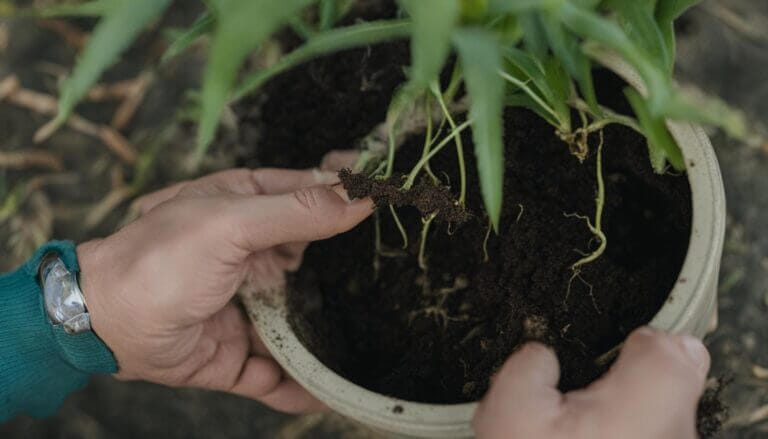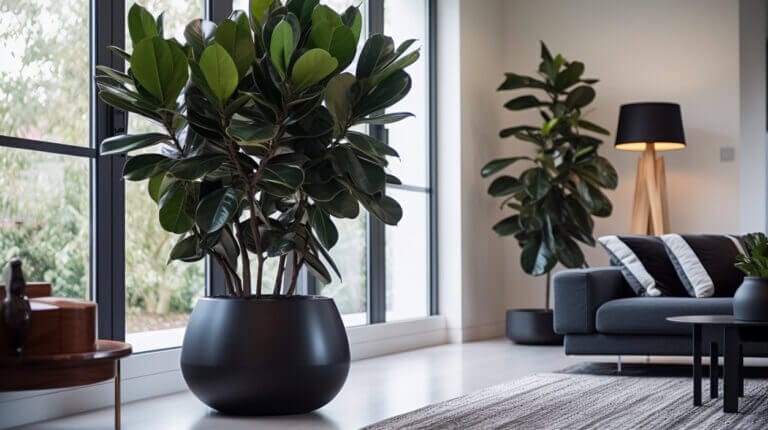If your Boston fern is struggling and showing signs of decline, it’s important to take immediate action to revive it and bring back its lush green glory. To save a dying Boston fern, it’s crucial to address the common causes of decline, such as overwatering, low humidity, incorrect lighting, underwatering, and pest infestations. By understanding these issues and implementing the appropriate solutions, you can give your fern the care it needs to flourish.
Key Takeaways:
- Overwatering is a common cause of decline in Boston ferns, leading to root rot. To rescue your fern, carefully remove it from the pot, trim affected roots, rinse healthy roots, and replant in well-draining soil.
- Low humidity can be improved by grouping plants together, using a humidity tray, or utilizing a humidifier to create a more suitable environment for your fern.
- Incorrect lighting can hinder fern growth. Provide bright, indirect light and avoid exposing your fern to direct sunlight to optimize its health.
- Regularly check the moisture level of the soil to prevent underwatering. Develop a watering routine based on the fern’s needs to ensure it receives adequate hydration.
- Inspect your fern regularly for any signs of pest infestations. If pests are present, use appropriate methods to eliminate them and restore your fern’s vitality.
- Epsom salt can be beneficial for Boston ferns, as it provides essential nutrients. Sprinkle a small amount of Epsom salt on the soil to promote healthier growth.
By addressing these issues and providing proper care, a dying Boston fern can often be revived. Put these strategies into practice, and watch your fern thrive once again!
Common Causes of Decline and How to Address Them
To save your dying Boston fern, it’s crucial to understand the common causes of decline and know how to tackle each issue effectively. Overwatering is the most common cause, resulting in root rot. If you suspect overwatering, gently remove the plant from the pot and examine the roots. Prune off any affected roots, making sure to use clean and sharp tools. Rinse the healthy roots under running water to remove any excess moisture and then repot the fern in well-draining soil.
Low humidity can also contribute to the decline of your Boston fern. To improve humidity levels, consider grouping your plants together. This creates a microclimate that helps retain moisture. Another option is to place a humidity tray filled with water near the fern. As the water evaporates, it increases the humidity around the plant. Alternatively, you can use a humidifier to raise humidity levels in the room.
Incorrect lighting can negatively impact the health of your Boston fern. These plants thrive in bright, indirect light. Avoid placing them in direct sunlight, as it can scorch the delicate fronds. If you notice your fern is not getting enough light, try moving it to a brighter location. You can also supplement natural light with artificial grow lights specifically designed for indoor plants.
Underwatering is another common cause of decline for Boston ferns. To avoid this issue, check the soil moisture regularly by sticking your finger about an inch deep into the soil. If it feels dry, it’s time to water. Develop a watering routine that ensures the plant receives adequate moisture, but be careful not to overwater. It’s better to underwater slightly than to overwater.
Pest infestations can also weaken Boston ferns. Regularly inspect your plant for signs of pests such as spider mites or mealybugs. If you notice any infestation, take immediate action to eliminate the pests. Depending on the severity, you may need to use insecticidal soap or neem oil. Additionally, you can try using natural remedies like a mixture of water and mild dish soap or rubbing alcohol. Remember to follow the instructions carefully when using any pest control method.
In addition to addressing these common issues, you can give your Boston fern a nutrient boost by using Epsom salt. Dissolve a teaspoon of Epsom salt in a gallon of water and use this solution to water your fern once a month. The magnesium and sulfur in Epsom salt provide essential nutrients that can promote healthy growth.
By understanding and addressing the common causes of decline, along with providing proper care, you can often revive a dying Boston fern and enjoy its lush foliage once again.
FAQ
What is the most common cause of decline for a Boston fern?
The most common cause of decline for a Boston fern is overwatering, which can lead to root rot.
How can I fix root rot in a dying Boston fern?
To fix root rot, gently remove the plant from the pot, prune off affected roots, rinse healthy roots, and repot in well-draining soil.
How can I improve low humidity for my Boston fern?
Low humidity can be improved by grouping plants together, using a humidity tray, or using a humidifier.
What should I do if my Boston fern is not getting enough light?
If your Boston fern is not getting enough light, provide bright, indirect light and avoid direct sunlight.
How can I avoid underwatering my Boston fern?
To avoid underwatering, check the soil moisture regularly and develop a watering routine.
What should I do if my Boston fern has a pest infestation?
If your Boston fern has a pest infestation, inspect the plant regularly and use appropriate methods to eliminate the pests.
Can I use Epsom salt to revive a dying Boston fern?
Yes, Epsom salt can be used to provide essential nutrients to the fern.
How can I provide proper care to revive a dying Boston fern?
By addressing the common causes of decline and providing proper care, a dying Boston fern can often be revived.







